WooCommerce Google Analytics Pro 1.3.3 Extension
WooCommerce Google Analytics Pro 1.3.3 Extension
Download
https://sellfy.com/p/Rrls/
Get it now
WooCommerce Google Analytics Pro
How to Get Started
- Buy this extension
- Download and install into your WooCommerce store
- Login to your Google Analytics account (sign up for free if you don’t already have an account) and connect it to this plugin
- Enabled enhanced eCommerce tracking in your GA account
- That’s it! Sit back and enjoy detailed site analytics!
Get Insights Into Your WooCommerce Sales Funnel with Google Analytics Pro
WooCommerce Google Analytics Pro turbo charges the integration between your WooCommerce store and your free Google Analytics account. Get detailed insights in your shop’s traffic and eCommerce events so that you can improve your sales funnel and drive more revenue.
Not sure if you need the free plugin or this Pro version? Check out our comparison here.
WooCommerce Google Analytics Pro adds advanced event tracking to your WooCommerce store and automatically pushes these events into Google Analytics, letting you easily get insights into important metrics like average order value, conversion rate, sales by product or category, and other valuable data.

Detailed Tracking with Easy Setup
Once you’ve installed WooCommerce Google Analytics Pro, you can choose your event names (if you don’t like the defaults), ensure that enhanced eCommerce tracking is enabled in your GA account, and then you’re ready to go! The plugin handles tracking and sending all of the appropriate events to Google Analytics so you can easily access your sales data and valuable store metrics.

It only takes 3 clicks to get your WooCommerce store connected to your Google Analytics account.
Why use Google Analytics Pro
- Provides basic site tracking and analytics, such as pageviews or customer sessions
- Includes all of the great features the free version has, like Universal Analytics and enhanced eCommerce tracking, but with more advanced event tracking
- Allows you exclude shop managers from tracking along with site admins
- Track User IDs for more accurate user counts
- Tracks basic eCommerce events like “add to cart” or “checkout started”
- Adds advanced eCommerce event tracking, such as “coupon addition / removal” and “cart quantity changed”
- Track manually added orders
- Adds events for customer actions, such as sign in or out, or leaving a product review / comment
- Adds order refund and cancellation tracking
- Track customer email opens as events in the “Emails” category
- Includes full support for Shopping Behavior and Checkout Behavior analysis reports NEW
- Adds checkout options to get deeper insights into checkout choices made by customers, such as selected payment method NEW
Detailed Event Tracking
The advanced event tracking in WooCommerce Google Analytics Pro gives you even more details about your sales process, and you can track things like “viewed account” or “coupon applied” to get a full view of what customers do on your site. You can also track these events in your purchasing workflow, such as viewing coupon data for orders and conversion rates with coupons.
Advanced eCommerce Reports
Full support for generating Shopping or Checkout Behavior analyses is included! View the customer lifecycle with your browsing and purchasing experience in the Shopping Behavior report:
Or see your checkout in fine-grained detail to gain more insight into where customers leave at that point in the purchasing process:
This plugin even provides support for sending checkout options to filter your checkout sessions based on customer actions or data:
Powerful Customization
All event names are customizable through the plugin settings and can be individually disabled. User IDs can also be tracked for more accurage user counts. Custom events can be tracked by adding a snippet to your theme.

WooCommerce Google Analytics Pro
Google Analytics is a free web analytics tool that tracks visitors and pageviews on your site. WooCommerce Google Analytics Pro integrates with your Google Analytics account to track eCommerce events in your store, including advanced event tracking such as purchases, product reviews, coupon usage, full order refunds, and more.
Uses enhanced eCommerce tracking to provide valuable metrics on your store’s performance.
Not sure if you need the free plugin or this Pro version? Check out our comparison here.
Installation
- Download the extension from your WooCommerce dashboard
- Go to Plugins > Add New > Upload and select the ZIP file you just downloaded
- Click Install Now, and then Activate
- Click the Configure link and read the next section to learn how to setup and configure the plugin.
Setup and Configuration
Configure the plugin by going to WooCommerce > Settings > Integrations. You will see ‘Google Analytics Pro’ listed as an option. Click this to see the settings.
Extension Settings
- Enable GA Tracking – Enable / check this to enable Google Analytics tracking. Disable this to disable tracking completely.
- Google Analytics Property – Click to authenticate the plugin with the Google Analytics Property for your site.
- Google Analytics Tracking ID – (If manually entering a tracking ID — not recommended) Input your Google Analytics property’s tracking ID to track events under the correct property.
- Track Administrators? – Enable this to track actions by administrators and shop administrators. Leave disabled to exclude events from these users.
- Tracking Options – Determine if you want to enable Display Advertising, Use Enhanced Link Attribution, Anonymize IP address (may be required by your country), and / or Track User IDs. We recommend anonymizing IP addresses and tracking user IDs, as tracking user IDs counts logged in users as one user (even across multiple devices), making your user count more accurate.
- Track Product impressions on – Determine when product impressions should be tracked: on single product pages, and / or archive pages (ie the shop). If you encounter “No HTTP response detected” errors, chances are you’re tracking more impressions than Google Analytics allows; please remove “Archive pages” from this setting if so.
- Logging – Log nothing (default), or turn on to add debugging information to the PHP error log. Be careful when enabling this on a busy site, as it can quickly flood the PHP error log. For best performance, leave logging disabled unless you experience issues with the plugin.

Customize Event Names
Every event name sent to Google Analytics can be changed by editing the text field associated with each event. This is useful if you have an existing implementation and want to keep your event names consistent.
To disable tracking of a particular event, clear the text field associated the event.
- Signed In – Triggered when a customer signs in. The sign in can occur anywhere (wp-login.php, my account page, sign in widget, etc) and it will be tracked. Users are identified as soon as they login and are tracked as that identity until they logout (if you enable user ID tracking).
- Signed Out – Triggered when a customer signs out. Identities are cleared upon logout, so if multiple people use the same computers but use different logins, this will help to track them all accurately.
- Viewed Signup – Triggered when a visitor views the sign up (my account / registration) page. Hooks into the WordPress register form and will track anywhere it is used.
- Signed Up – Triggered when a visitor registers an account. Hooks into the WordPress registration system and will track registrations anywhere the WordPress register form is used.
- Viewed Homepage – Triggered when a visitor views the homepage.
- Viewed Product – Triggered when a visitor views a single product. The ‘Product Name’ is tracked as an event label.
- Clicked Product – Triggered when a visitor clicks on a product in a listing, such as the shop or search results. The ‘Product Name’ is tracked as an event label.
- Added to Cart – Triggered when a visitor adds an item to their cart, either on a single product page or via an AJAX link on category pages. Hooks into the ‘woocommerce_add_to_cart’ action, so custom add-to cart-links should track as well. Labels: Product Name, Quantity, Category, and Attributes (if product is a variation).
- Removed from Cart – Triggered when a visitor removes an item from their cart. Labels: Product Name.
- Changed Cart Quantity – Triggered when a visitor increases or decreases the number of units in their cart. This event can be recorded very frequently if visitors to your site tend to have a large number of unique items in their cart. In this case, you can safely disable this event. Labels: Product Name, Quantity.
- Viewed Cart – Triggered when a visitor views the cart. This will also track when the cart is empty.
- Applied Coupon – Triggered when a visitor applies a coupon on either the cart or checkout. Labels: Coupon Code.
- Removed Coupon – Triggered when a visitor removes a coupon on either the cart or checkout. Labels: Coupon Code.
- Started Checkout – Triggered when a visitor starts the checkout process.
- Provided Billing Email – Triggered when a visitor provides a billing email on the checkout page.
- Selected Payment Method – Triggered when a visitor chooses a payment method at checkout.
- Started Payment – Triggered when a customer starts the payment process. This will only track if you are a using a payment gateway that uses a “Pay” page, such as Chase Paymentech or Authorize.Net SIM.
- Completed Purchase – Triggered when a customer’s purchase has been submitted or paid for. This will track for gateways that immediate complete payment, such as credit cards, or those that place the order for a later payment, such as a “Check Payment” order. Labels: Order ID, Order Total, Shipping Total, Total Quantity, Payment Method.
- Wrote Review – Triggered when a visitor writes a review of a product. This is tracked before spam processing, so if you get a lot of spam, you can consider disabling this event. Labels: Product Name.
- Commented – Triggered when a visitor writes a comment on a blog post. This is tracked before spam processing, so if you get a lot of spam, you can consider disabling this event. Labels: Post Title.
- Viewed Account – Triggered when a customer views the ‘My Account’ page.
- Viewed Order – Triggered when a customer views an order.
- Updated Address – Triggered when a customer updates their billing or shipping address.
- Changed Password – Triggered when a customer changes their password.
- Estimated Shipping – Triggered when a visitor estimates shipping from the cart page. Labels: Country.
- Tracked Order – Triggered when a customer submits the ‘Order Tracking’ form.
- Cancelled Order – Triggered when a customer cancels a pending order.
- Order Refunded – Triggered when an order has been fully refunded.
- Reordered – Triggered when a customer reorders a previous order.
(Click to view larger images)
Checkout Funnel Settings
The Checkout Behavior Analysis will automatically be populated, so long as at least 1 event in the funnel is being tracked for your site. These events or the order cannot be configured, as they need to be static steps sent to Google for every checkout. You can track all 4 events to gain insight into how much of the checkout process customers complete, or delete an event name to stop tracking it.
These steps can be re-named in your Google Analytics account if desired by going to Admin > eCommerce settings:
You can then add custom names for the steps you have enabled on your site. Note that this does not influence what events are tracked. The tracked events are static, but you can choose any name you want for steps 1 – 4 (or less if you have disabled some events).
To learn more about what the Checkout Behavior Analytics tracks, please read more about tracked funnels.
Authenticating with GA
Before you connect to your Google Analytics account, please be sure Universal Analytics is enabled. You can follow this guide to check that it’s enabled for the account / property you want to track with this plugin.
There are two ways to connect the plugin to your Google Analytics account: by authenticating or by manually entering your tracking ID. We strongly recommend authenticating rather than manual entering. This is more reliable and will ensure that any future feature additions will be supported without further action from you.
Authenticating
To authenticate the plugin with your Google Analytics account, click the “Authenticate” button in the plugin settings. This will begin the authentication process.
- Google will ask you to allow the plugin the permissions listed. Click “Allow”.

- This will populate the profile dropdown with your Google Analytics properties.

- Select the correct property from the list and save your settings.
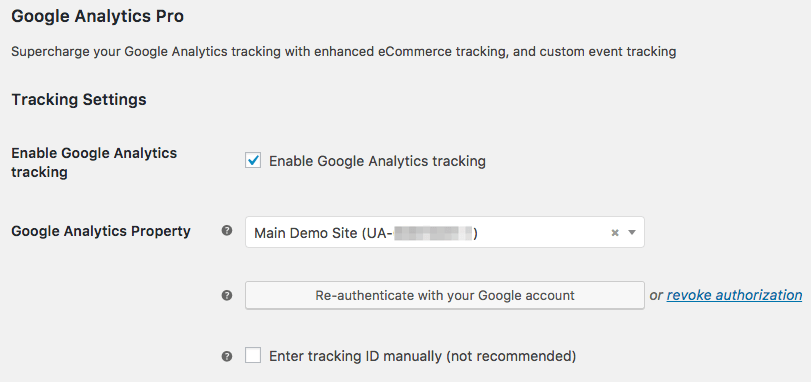
Manual Entry
To manually enter your Tracking ID, log into your Google Analytics account.
- Go to “Admin” at the top and select “Property Settings” for the correct property.

- Under the property settings, copy the Tracking ID listed.

- Paste this Tracking ID into the plugin settings.

Your GA Account
Once you’ve connected your Google Analytics account and set up event names, you can save the plugin settings, and eCommerce tracking data will begin to show up in your Google Analytics account within 24 hours. You can read more about enhanced eCommerce tracking here.
Once you’ve saved the plugin events settings, the plugin will add all of the events you’ve configured as events in your GA dashboard.
You can also view event categories (such as “Product”) for a more detailed view.
Want to learn more? Check out: How to Use Enhanced eCommerce in GA.
Tracking Funnels
The plugin sends all events for the Shopping Behavior Analysis and Checkout Behavior Analysis reports, so you’ll see these funnels within your GA account.
Shopping Behavior Analysis
The Shopping Behavior analysis report is automatically generated from the events the plugin sends to Google Analytics. This shows general insight into store browsing experience and where customers enter or leave your purchasing funnel. This is useful to see cart and checkout abandonment for the store.
There are no settings required for the Shopping Behavior funnel; it will automatically be populated based on pageview, add to cart, checkout, and transaction events.
Checkout Behavior Analysis
The Checkout Behavior Analysis is populated with the steps the plugin has listed under its settings. This is a static funnel that is intended to be a “zoomed-in” view of the “Sessions with Check-Out” part of the Shopping Behavior funnel. The Checkout Behavior analysis gives you a more fine-grained look at where customers leave the checkout process.
While it’s most useful for sites with multi-step checkouts, this plugin will use events within this report that are relevant to any WooCommerce store, regardless of whether selling digital goods, shippable items, or other checkout processes. Please note that if you use express or off-site payment methods, especially if the customer leaves the site from the cart page, then this report may be skewed or may not have full data for your site.
There are up to 4 steps tracked, and 3 of these steps will have “Checkout options” associated with them. Google Analytics allows one checkout option per event to allow you further insight into this funnel, and the ability to create segments based on these options.
| STEP | EVENT | CHECKOUT OPTION |
|---|---|---|
| 1 | started checkout | logged-in status (guest vs registered) |
| 2 | entered billing email | – |
| 3 | selected payment method | chosen payment method |
| 4 | placed order | chosen shipping method* |
*only if shipping is enabled for the store / this checkout
Other Information
Basic Site Tracking
Google Analytics Pro includes basic site tracking, such as pageviews and customer sessions, so no other Google Analytics plugin is needed to get complete analytics for your store.
As such, if you’ve already used the free WooCommerce Google Analytics plugin for basic or eCommerce tracking, Google Analytics Pro will deactivate this plugin upon installation.
Monster Insights Compatibility
If you’ve already used Monster Insights (formerly Google Analytics by Yoast) for general site analytics, then WooCommerce Google Analytics Pro will respect this plugin’s settings, and will work with it for your site authentication.
If you have both plugins enabled, this plugin will defer to Monster Insights for basic site tracking, and will notify you as such.
Upgrading to v1.3.0
When upgrading to version 1.3.0 of the plugin, you’ll notice that the global javascript function has been renamed from the legacy
__gaTracker to ga. This will not affect most sites, and you can adjust the plugin settings to use ga accordingly.
However, if you have custom javascript implemented for your site, you may want to ensure that these customizations are updated to use the
ga global function before changing this within the plugin settings.
You should also be aware that the completed payment event is no longer necessary. Instead, completed purchase tracks purchases for all orders, both off-site and on-site gateways. If you’ve created custom analytics goals, these should be updated accordingly.
Frequently Asked Questions
Q: Does this plugin support Shopping Behavior Analysis and Checkout Behavior Analysis reports?
A: Absolutely! Check out our details on tracking funnels above for more info.
A: Absolutely! Check out our details on tracking funnels above for more info.
Q: Will this plugin let me get my conversion rate?
A: Both the free plugin and this pro version will give Google Analytics the data it needs to calculate your site’s conversion rate. The Pro version includes more accurate conversion rate tracking since it doesn’t require purchases to end up on the “thank you” page in order to be tracked, so orders via any payment method are tracked as conversions.
A: Both the free plugin and this pro version will give Google Analytics the data it needs to calculate your site’s conversion rate. The Pro version includes more accurate conversion rate tracking since it doesn’t require purchases to end up on the “thank you” page in order to be tracked, so orders via any payment method are tracked as conversions.
Google has more details on enhanced eCommerce reporting here.
Q: Does this plugin track order currency?
A: Yep! Both the free and pro Google Analytics plugins for WooCommerce will track order currency. Please note that Google Analytics does not allow displaying totals in multiple currencies; it will convert each transaction to your global currency (from your account settings) each day when a different currency code is sent.
A: Yep! Both the free and pro Google Analytics plugins for WooCommerce will track order currency. Please note that Google Analytics does not allow displaying totals in multiple currencies; it will convert each transaction to your global currency (from your account settings) each day when a different currency code is sent.
Q: When is a purchase considered “completed”?
A: To ensure all purchases are tracked, regardless of whether the payment takes place offsite, on-site, the gateway calls “payment completed” on the order, etc., Google Analytics Pro has to rely on the order status to indicate the financial status. As such, any order that’s marked as “processing” or “completed” will have the “completed purchase” event tracked in Google Analytics.
A: To ensure all purchases are tracked, regardless of whether the payment takes place offsite, on-site, the gateway calls “payment completed” on the order, etc., Google Analytics Pro has to rely on the order status to indicate the financial status. As such, any order that’s marked as “processing” or “completed” will have the “completed purchase” event tracked in Google Analytics.
Troubleshooting
Known Issues
- Admin / Shop Manager users are still tracked as “Visited Site” when visiting the website to login. There is no way to prevent this, since we don’t know they’re admin users until they login.
- Only full refunds for orders are tracked, partial refunds are not supported because Google does not accept the product identifier when sending a partial refund. We’re actively looking at ways to work around this or determine if it’s a known bug with the GA API.
- Checkout Behavior Analysis reports will not use a custom set of steps. While you can name these steps whatever you’d like in your GA account, the report will consist of the pre-defined steps the plugin sends, which can be viewed on the settings page.
- If a customer is a little click-happy and double / triple clicks an AJAX add to cart link, the “added to cart” event may be recorded multiple times. Multiple items will be added to the cart, so you may also see cart quantity changes reflected.
Other Issues
Not seeing tracking data in Google Analytics? It can take up to 24 hours for data to populate, so please keep this in mind.
If it’s been longer than 24 hours, please follow these steps to make sure everything is setup correctly before posting a support request:
- Check that your tracking ID is correct or that you are authenticated with Google Analytics.
- Double-check that your tracking ID is correct
- View the source of your homepage to make sure the Google Analytics javascript code exists. If you’ve added this javascript manually, it needs to be removed, as it will override the data the plugin sends to Google Analytics.
- Please ensure your Google Analytics property is using Universal Analytics, as Google requires this for enhanced eCommerce support.
- If you see “No HTTP Response detected” errors, please disable product impression tracking on archive pages.
- If Google Analytics still isn’t working, please enable logging and submit a help request detailing what happened while following these steps and describing the issue so we can help you quickly! Add the log as an attachment is also helpful.
For Developers
Tracking Custom Events
You can track custom events by using:
wc_google_analytics_pro()->get_integration()->custom_event( $event_name, $properties );
Event name can be set as a string, while properties are passed as an array with property name => value.
You can modify this sample snippet according to your needs with the help of a developer:
if ( ! function_exists( 'my_custom_event_function' ) ) {
function my_custom_event_function() {
wc_google_analytics_pro()->get_integration()->custom_event( 'Event name', array( 'Property name' => 'value' ) );
}
add_action( 'hook_to_trigger_event_on', 'custom_event_function' );
}
The
custom_event() can also be called without properties by omitting the second parameter.




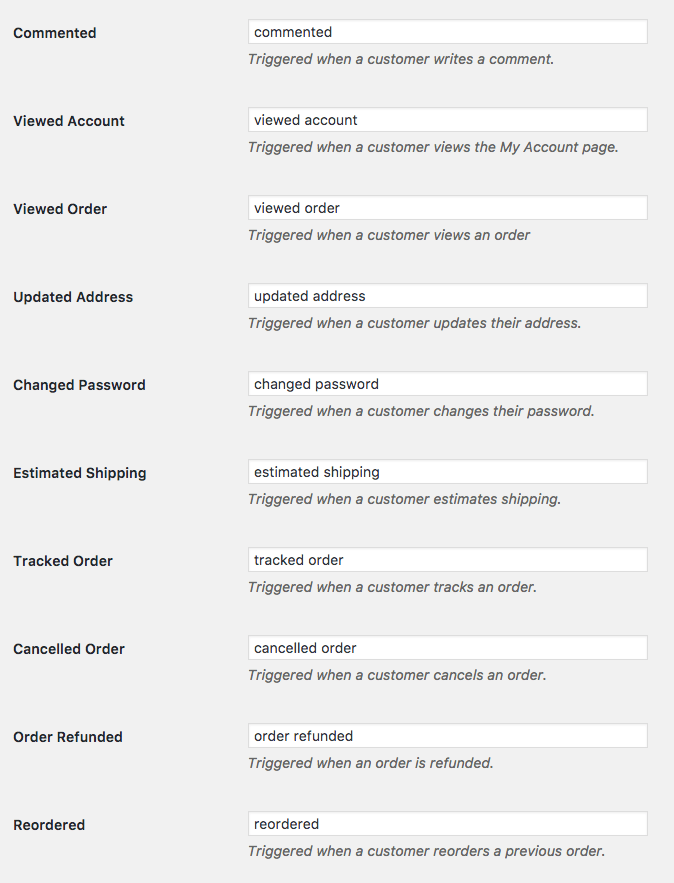
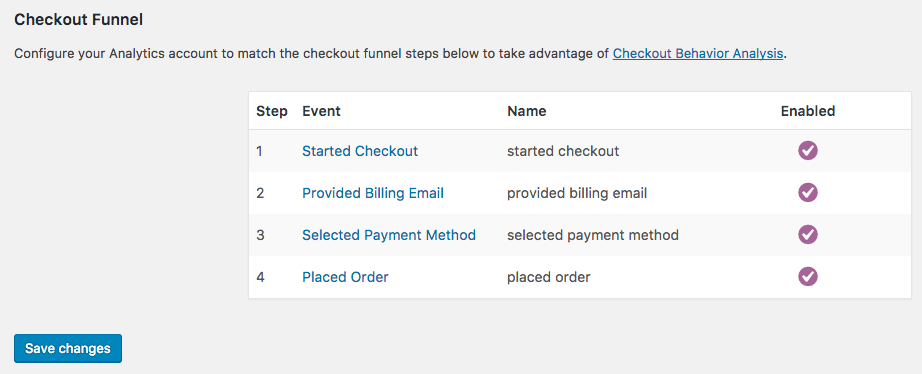

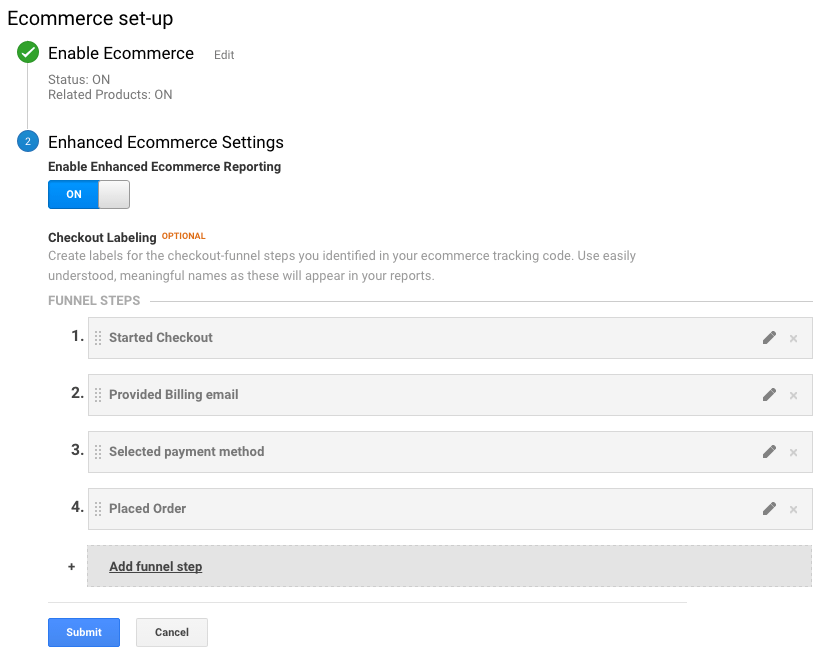
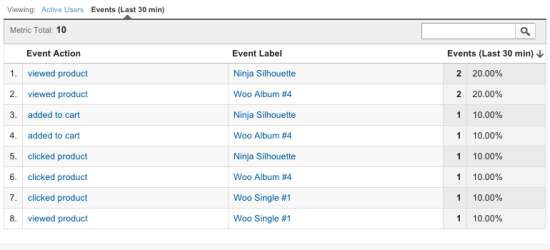



0 Comments:
Post a Comment
Note: only a member of this blog may post a comment.
Subscribe to Post Comments [Atom]
<< Home